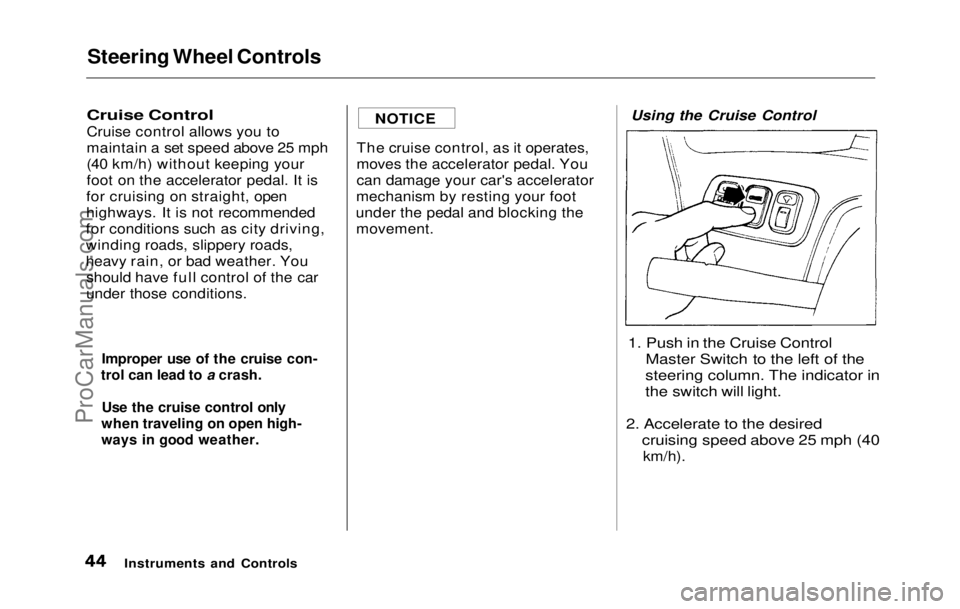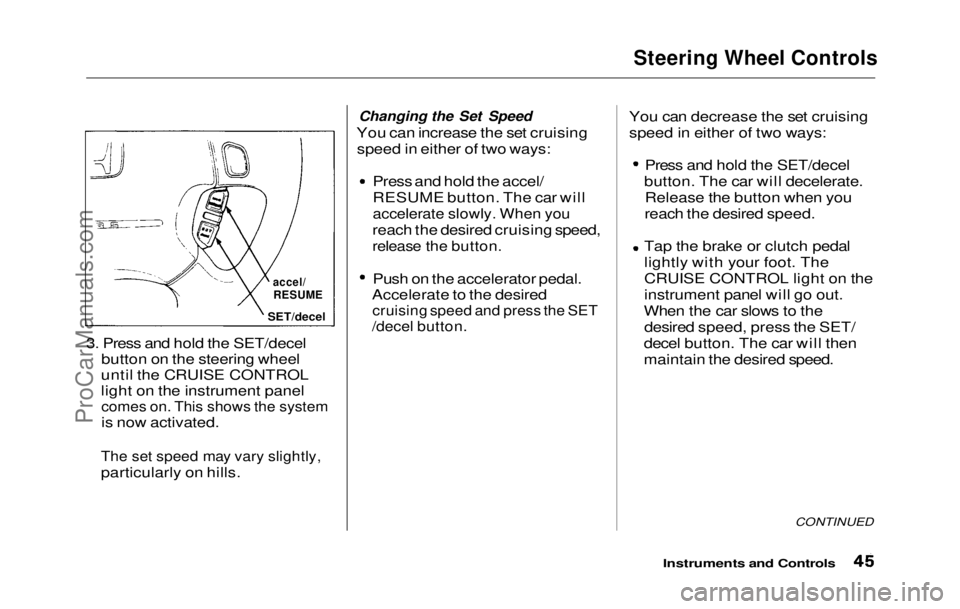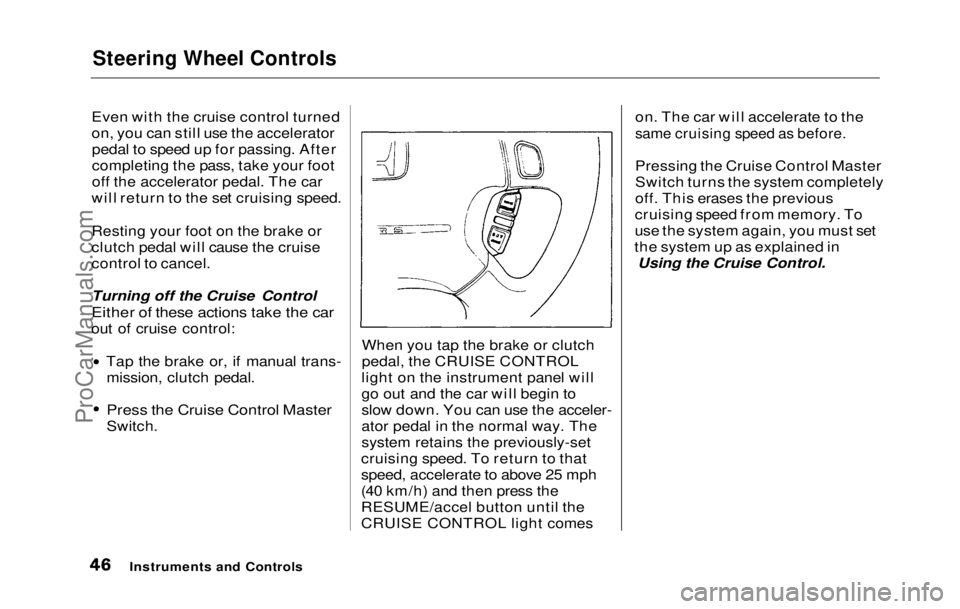Page 40 of 225

Controls Near the Steering Wheel
Headlights
The rotating switch on the left
lever controls the lights. Turning this switch to the first position
turns on the parking lights, tail
lights, instrument panel lights, side-marker lights, and rear license
plate lights. Turning the switch to the second position turns on
the headlights. If you leave the lights on with the
ignition switch in ACCESSORY (I)
or LOCK (0), you will hear a
reminder chime when you open the
driver's door.
To change between low beams and
high beams, pull back on the turn signal lever until you hear a click,
then let go. The high beam indica-
tor will light (see page 35). To flash the high beams, pull back
and hold the turn signal lever.
Release the lever and the high
beams will go off.
The high beams will stay on for as
long as you hold the lever, no matter what position the headlight
switch is in.
Daytime Running Lights
(Canadian Models)
With the headlight switch off, the
high beam headlights come on with
reduced brightness when you turn
the ignition switch to ON (II) and
release the parking brake. They
remain on until you turn the
ignition off, even if you set the
parking brake.
The headlights revert to normal
operation when you turn them on
with the switch.
Instruments and ControlsProCarManuals.comMain Menu Table of Contents s t
Page 41 of 225

Controls Near the Steering Wheel
Instrument Panel Brightness
The dial
on the dashboard to the
left of the instrument panel con- trols the brightness of the instru-
ment panel lights. Turn the dial to
adjust the brightness.
To reduce glare at night, the fuel and temperature gauges dim when
you turn on the parking lights or
headlights. You then adjust their
brightness when you adjust the instrument panel brightness. Turn the dial up as far as it will go to
return the fuel and temperature
gauges to their daytime brightness.
Turn Signals
Signal a turn or lane change with
this lever. Push down on the lever
to signal a left turn, and up to
signal a right turn. If you push it up
or down all the way, the turn signal
continues to blink even when you
release the lever. It shuts off auto-
matically as you complete the turn. To signal a lane change, push
lightly on the turn signal lever in
the proper direction and hold it.
The lever will return to the center position as soon as you release it.
Instruments and Controls
TURN SIGNAL LEVERProCarManuals.comMain Menu Table of Contents s t
Page 42 of 225
Controls Near the Steering Wheel
Windshield Wipers
The right lever controls the wind-
shield wipers and washers. The
rotary switch at the end of the
lever has three positions:
INT — intermittent
LO — low speed
HI — high speed
In intermittent, the wipers operate
every few seconds. In low speed
and high speed, the wipers run
continuously.
To operate the wipers in mist mode,
push the control lever down. The
wipers run at high speed until you
release the lever. This gives you a
quick way to clear the windshield. Windshield Washers
To clean the windshield, pull back
on the wiper control lever. The
washers spray until you release the
lever.
The wipers run at low speed while
you're pulling the lever, then
complete one more sweep of the
windshield after you release it.
Instruments and ControlsProCarManuals.comMain Menu Table of Contents s t
Page 43 of 225
Controls Near the Steering Wheel
Steering Wheel Adjustment
You can adjust the steering wheel height to suit your preference. Do
this before you begin driving.
1. Adjust the seat so you are acomfortable distance from the
pedals.
2. The lever to tilt the steering
wheel is under the steering column to the left. Push this
lever all the way down.
3. Move the steering wheel up or
down to the desired position.
Position the wheel so you can see
all the instrument panel gauges
and warning lights. Push the
lever up to lock the steering
wheel in that position.
4. Make sure you have securely locked the steering wheel inplace by trying to move it up and
down.
Instruments an d
Controls
Adjusting the steering wheel
position while driving may
cause you to lose control of
the car and be seriously injured in a crash.
Adjust the steering wheel only
when the car is stopped.ProCarManuals.comMain Menu Table of Contents s t
Page 44 of 225

Steering Wheel Controls
Cruise Control
Cruise control
allows you to
maintain a set speed above 25 mph
(40 km/h) without keeping your
foot on the accelerator pedal. It is
for cruising on straight, open
highways. It is not recommended
for conditions such as city driving,
winding roads, slippery roads,
heavy rain, or bad weather. You should have full control of the car
under those conditions. The cruise control, as it operates,
moves the accelerator pedal. You
can damage your car's accelerator
mechanism by resting your foot
under the pedal and blocking the movement. Using the Cruise Control
1. Push in the Cruise Control
Master Switch to the left of the
steering column. The indicator in
the switch will light.
2. Accelerate to the
desired
cruising speed above 25 mph (40
km/h).
Instruments an d
Controls
Improper use of the cruise con-
trol can lead to a crash.
Use the cruise control only
when traveling on open high-
ways in good weather.
NOTICEProCarManuals.comMain Menu Table of Contents s t
Page 45 of 225

Steering Wheel Controls
3. Press and hold the SET/decel button on the steering wheel
until the CRUISE CONTROL
light on the instrument panelcomes on. This shows the system
is now activated.
The set speed may vary slightly,
particularly on
hills.
Changing the Set Speed
You can increase the set cruising speed in either of two ways:
Press and hold the accel/
RESUME button. The car will
accelerate slowly. When you
reach the desired cruising speed,
release the button.
Push on the accelerator pedal.
Accelerate to the desired
cruising speed and press the SET
/decel button.
Yo
u can decrease the set cruising
speed in either of two ways: Press and hold the SET/decel
button. The car will decelerate. Release the button when you
reach the desired speed.
Tap the brake or clutch pedal
lightly with your foot. The
CRUISE CONTROL light on the
instrument panel will go out.
When the car slows to the desired speed, press the SET/
decel button. The car will then
maintain the desired speed.
CONTINUED
Instruments and Controls
accel/
RESUME
SET/decelProCarManuals.comMain Menu Table of Contents s t
Page 46 of 225

Steering Wheel Controls
Even with the cruise control turned
on, you can still use the accelerator pedal to speed up for passing. After
completing the pass, take your foot
off the accelerator pedal. The car
will return to the set cruising speed.
Resting your foot on the brake or
clutch pedal will cause the cruise
control to cancel.
Turning off the Cruise Control
Either of these actions take the car
out of cruise control:
Tap the brake or, if manual trans-mission, clutch pedal.
Press the Cruise Control Master
Switch.
When you tap the brake or clutch
pedal, the CRUISE CONTROL
light on the instrument panel will
go out and the car will begin to
slow down. You can use the acceler-
ator pedal in the normal way. The
system retains the previously-set
cruising speed. To return to that
speed, accelerate to above 25 mph
(40 km/h) and then press the
RESUME/accel button until the
CRUISE CONTROL light comes on. The car will accelerate to the
same cruising speed as before.
Pressing the Cruise Control Master
Switch turns the system completely
off. This erases the previous
cruising speed from memory. To
use the system again, you must set
the system up as explained in Using the Cruise Control.
Instruments and ControlsProCarManuals.comMain Menu Table of Contents s t
Page 47 of 225
Steering Wheel Controls, Keys and Locks
Horn
Press either of the buttons on the
steering wheel spokes to sound the
horn.
Key
s
Your
car comes with two kinds of
keys: a master key and a valet key.
The master key fits all locks on
your car: Ignition
Doors
Trunk
Trunk release handle
Rear seat trunk access
Center console compartment
The valet key only works the
ignition and the door locks. You
can keep the trunk, trunk release
handle, center console compart-
ment and rear seat trunk access
locked when you leave your car and valet key at a parking facility.
Each key has a number stamped in
one side. You will need this number
if you have to get a lost key re-
placed. Record this number and
keep it in a safe place.
Instruments and Controls
HORN
VALET KEYMASTER KEY
ProCarManuals.comMain Menu Table of Contents s t